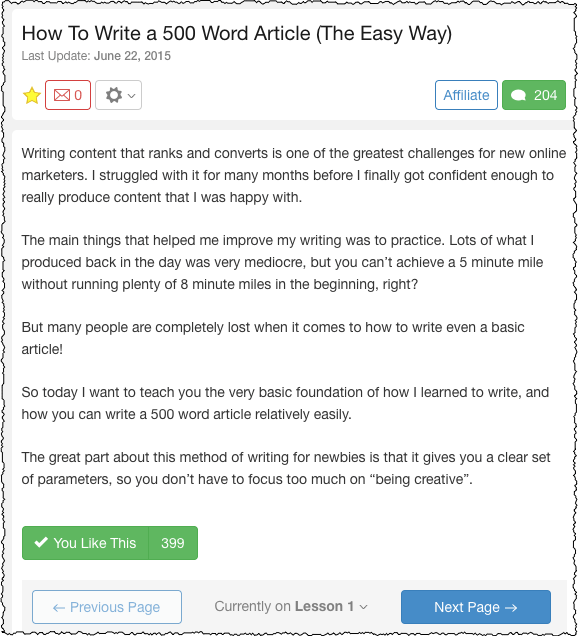
Build An Income-Generating Website That Lasts Decades!
Earn online income for a lifetime.
In my experience as an online marketer for the past decade, the more you write, the more traffic you get. The more you traffic you have to your site, the more you can tweak and funnel those visitors towards earnings. It takes practice to get it right, but the important beginning step is being able write proficiently.
Most people fail because they simply can’t write a full article on any topic, let alone write a piece of content convincing the reader to buy something.
So how do you become a good writer if you’re not already good at it?
Having a system or a template to help you generate content quickly could make all the difference in your new online business.
One of the best ways to write quick, powerful blog posts that sell products and make you money is to utilize a basic 5-paragraph essay format. Did you learn the five paragraph essay in high school? This format really stuck with me over the years because it was a logical way to organize my ideas, and even when I wasn’t inspired, I could still knock out decent piece of content, then return to the piece when I was feeling a bit more motivated.
Oh, and do you hate writing? You’ll learn to love it once you see the connection between publishing and article and earning money. I wrote one article back in October 2017 that earned me $1000+ in June 2018!
- How To Write A Basic 500-Word Essay
- Introduction
- Supporting Points (Body)
- Write Your Conclusion
- See This Article In It’s Original Form, via Step by Step Lesson
- More tips on writing great articles for your website
- How To Use Keywords For SEO Videos 1-3
- Keywords Lesson 1
- Keywords Lesson 2
- Keywords Lesson 3
How To Write A Basic 500-Word Essay
First of all, you’re going to need to know what a basic essay looks like. Don’t worry, it’s not hard. The basic outline looks something like this:
- Introduction (100 words)
- Body
- Supporting Point (100 words)
- Supporting Point (100 words)
- Supporting Point (100 words)
- Conclusion (100 words)
Easy peasy, right? It’s simple right from the beginning, but it’s also versatile and can meet the needs of almost every type of blog post you want to write. We’ll discuss some ways to tweak this format later, but for now, let’s go through the separate parts of the essay format one by one.
For an online article, we want a 1000 word minimum for most topics, so you can double each of the sections to 200 words each. Alternatively, you can write a more lengthy introduction and conclusion, or you can add several more supporting points and subsections for each supporting point.
Introduction
The very basics of how to write an introduction is just to tell people what the article is going to be about – nothing more. You don’t need to have any fantastic insight or clever ideas to start off the article. Of course, any type of “hook” will keep your reader engaged, but we’re talking basics here. For your introduction, you’ll just cover the main three supporting points. Here’s an example introduction paragraph from my homebrewing website.

Supporting Points (Body)
For each supporting point, you can break down the paragraph into a “mini” essay, using 5 sentences. Again, our format is introduction, point 1-3, then conclusion. You’ll usually find that it’s hard to stick to this strict format, and your creativity will take over. However, the format is there as a safety net for when your writing gets off into the weeds. Here’s the first supporting paragraph based on my ideas from the introduction:

Notice the introduction and conclusion/transition sentence, as well using three ideas within this section. My three topics were (1) kegs, (2) tanks, (3) what not to buy. I could have expanded to many more items that you need to buy to keg beer, and written 500 words alone in this section!
Write Your Conclusion
The conclusion is going to be a general summary of the post. You can also finish up with reminding the read what they should have understood from the article. Following the basic format from above, you can also summarize each individual supporting paragraph as I’ve done below.

The highlighted section is a “call to action” I included to engage readers on the blog post. You call to action could be to have them buy something, have them sign up for an email list, or perhaps click to another page on your website.
See This Article In It’s Original Form, via Step by Step Lesson
In this post, I’ve summarized my original lesson, with more examples and details. Click the image below to access the full step by step lesson. You’ll be required to sign up for a free account to click through all the pages.
More tips on writing great articles for your website
If you’ve already chosen a niche, an affiliate partner, and a keyword to target, it’s time to get started on your article. Is your article going to be low competition article to garner traffic, or a money page to convert to sales?
- Research the topic — if you haven’t already researched the topic, take a few minutes to do some online searches and reading about the product. Having an idea of what your supporting paragraphs will be about can help you know what to search for. For each supporting paragraph, jot down a few figures, interesting facts or intriguing background stories about the product you’ll be promoting. This is also a good time to look for a good hook, like a real-world example, that you can use in the introduction.
- Brainstorm an outline — using the Introduction-Body-Conclusion template discussed above, write one to two sentences for the introduction and conclusion, and one to two sentences for each supporting paragraph.
- Refine your outline — once the research is complete, refining the outline is pretty easy. Just plug the notes you took into the outline with the supporting point paragraphs and introduction. Now get ready to write!
- Write the first draft — believe it or not, you’re already more than halfway there. All you have to do now is take the information you already have and connect the sentences together in interesting ways. Start at the top, with the introduction, and work your way down. You can measure word count as you go. Aim for 85-100 words for the introduction, around 100 words for each supporting point, and another 50-100 words for the conclusion. Because your article is already halfway fleshed out, it should take you less than an hour to write the article. (When you get good at it, you can do it in minutes.)
- Check for clarity — make sure the sentences are easy to understand. Then check for persuasiveness. This is actually the most important part, because you’ll need to be persuasive if you’re going to promote a product well. Ask yourself—if I didn’t know anything about this product in the beginning, would I be inclined to buy it after reading this blog post?
- Now you’re to the steps: refine it, check for spelling and grammar errors, and publish it on your website! Don’t forget to add any necessary links.
Now that you’ve read to the bottom of this article, I can see you’re hungry for more. See my newest training titled 8 Simple Article Styles To Make Money Online for my templates on writing different kinds of content for my affiliate websites.

